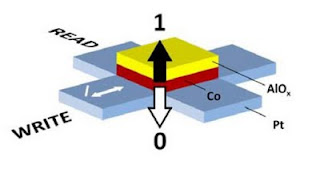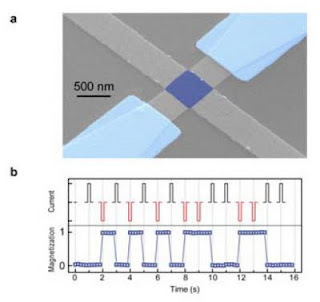The size of these magnetic domains has now reached a few tens of nanometers, allowing us to store a Terabyte of data in the space of just about 4 square centimeters. Miniaturization, however, has created numerous problems that physicists and engineers worldwide struggle to solve at the pace demanded by an ever-growing information technology industry. The process of writing information on tiny magnetic bits one by one, as fast as possible, and with little energy consumption, represents one of the biggest hurdles in this field.
As reported this week in Nature, a team of scientists from the Catalan Institute of Nanotechnology, ICREA, and Universitat Autonoma de Barcelona, Mihai Miron, Kevin Garello, and Pietro Gambardella, in collaboration with Gilles Gaudin and colleagues working at SPINTEC in Grenoble, France, have discovered a new method to write magnetic data that fulfils all of these requirements.

Schematic of a magnetic bit fabricated by sandwiching a thin ferromagnetic Co film between Pt and AlOx layers. Current pulses injected through one of the Pt strips switch the magnetization from up to dowand viceversa depending on the sign of the current.

Figure 2: a. Scanning electron micrograph of a reprogrammable magnetic switch fabricated by placing two "bar magnets" (light blue) on top of the current injection line (light gray). The magnetic bit is shown at the center (blue). b. The polarity of the current pulses (top panel) determines the direction of the magnetization (bottom panel). The amplitude and duration of each current pulse are about 2 mA and 9 ns, respectively.Magnetic writing is currently performed using magnetic fields produced by wires and coils, a methodology suffering severe limitations in scalability and energy efficiency. The new technique eliminates the need for cumbersome magnetic fields and provides extremely simple and reversible writing of memory elements by injecting an electric current parallel to the plane of a magnetic bit. The key to this effect lies in engineering asymmetric interfaces at the top and bottom of the magnetic layer, which induces an electric field across the material, in this case a cobalt film less than one nanometer thick sandwiched between platinum and aluminum oxide.
Due to subtle relativistic effects, electrons traversing the Co layer effectively see the material's electric field as a magnetic field, which in turn twists their magnetization. Depending on the intensity of the current and the direction of the magnetization, one can induce an effective magnetic field, intrinsic to the material that is strong enough to reverse the magnetization. The research team showed that this method works reliably at room temperature using current pulses that last less than 10 ns in magnetic bits as small as 200 x 200 square nanometers, while further miniaturization and faster switching appear easily within reach. Although there is currently no theory describing this effect, this work has many interesting applications for the magnetic recording industry, and in particular for the realization of magnetic random access memories, so-called MRAMs. By replacing standard RAMs, which need to be refreshed every few milliseconds, non-volatile MRAMs would allow instant power up of a computer and also save a substantial amount of energy.
An additional advantage of the discovery reported here is that current-induced magnetic writing is more efficient in "hard" magnetic layers than in "soft" ones. This is somehow counterintuitive, as soft magnetic materials are by definition the easier to switch using external magnetic fields, but very practical since hard magnets can be miniaturized to nanometer dimensions without losing their magnetic properties. This would allow the information storage density to be increased without compromising the ability to write it. The results of this work have also led to three patent applications dealing with the fabrication of magnetic storage and logic devices.
###
Discovery of new magnetic data writing technique could lead to next generation computer memory
Ioan Mihai Miron1, Kevin Garello1, Gilles Gaudin2, Pierre-Jean Zermatten2, Marius V. Costache1, Stéphane Auffret2, Sebastien Bandiera2, Bernard Rodmacq2, Alain Schuhl2, and Pietro Gambardella1,3,4
1 Catalan Institute of Nanotechnology (ICN-CIN2), E-08193 Barcelona, Spain
2 SPINTEC, UMR-8191, CEA/CNRS/UJF/GINP, INAC, F-38054 Grenoble, France
3 Departament de FÃsica, Universitat Autonoma de Barcelona (UAB), E-08193 Barcelona, Spain
4 Institució Catalana de Recerca i Estudis Avançats (ICREA), E-08010 Barcelona, Spain
DOI: 10.1038/nature10309 On-line version: was Published Sunday 31 July at 18h00 GMT Paper version: will be published in Nature on 11 August 2011.
CATALAN INSTITUTE OF NANOTECHNOLOGY (ICN)
The Catalan Institute of Nanotechnology (ICN) is a private foundation created in 2003 and forms part of CERCA, the Network of Research Centers launched by the Catalan Government as a key plank of the long-term strategy to foster the development of a knowledge-based economy. The ICN´s multicultural team of scientists, representing over 20 nationalities, aims to produce cutting-edge science and develop next-generation technologies by investigating the new properties of matter that arise from the fascinating behavior at the nanoscale.
Research is devoted on one side to the study and understanding of fundamental physical phenomena associated to state variables (electrons, spin, phonons, photons, plasmons, etc.), the investigation of new properties derived from tailored nanostructures, and the opening of new routes and fabrication processes for the conception of new nanodevices.
On the other side, researchers also explore the state of aggregation at the nanometric scale, the development of nanoproduction methods, synthesis, analysis, and manipulation of aggregates and structures of nanometric dimension, and the development of techniques for characterizing and manipulating nanostructures.
These lead to commercially relevant studies such as the functionalization of nanoparticles, the encapsulation of active agents, novel drugs and vaccines, new nanodevices and nanosensors, with applications in health, food, energy, environment, etc.
The Institute actively promotes collaboration among scientists from diverse areas of specialization (physics, chemistry, biology, engineering), and trains new generations of scientists, offering studentships, doctoral and post-doctoral positions.
More information: Institut Catala de Nanotecnologia Tel: +(34) 93 581 4408, Email: info@icn.cat, Web: www.icn.cat Communicacion Dept.: Ana de la Osa, ana.delaosa.icn@uab.es
Principal Researcher: Dr. Pietro Gambardella, ICREA Prof. and Physics Dep. Professor at Autonomous University of Barcelona (UAB), pietro.gambardella.icn@uab.es
